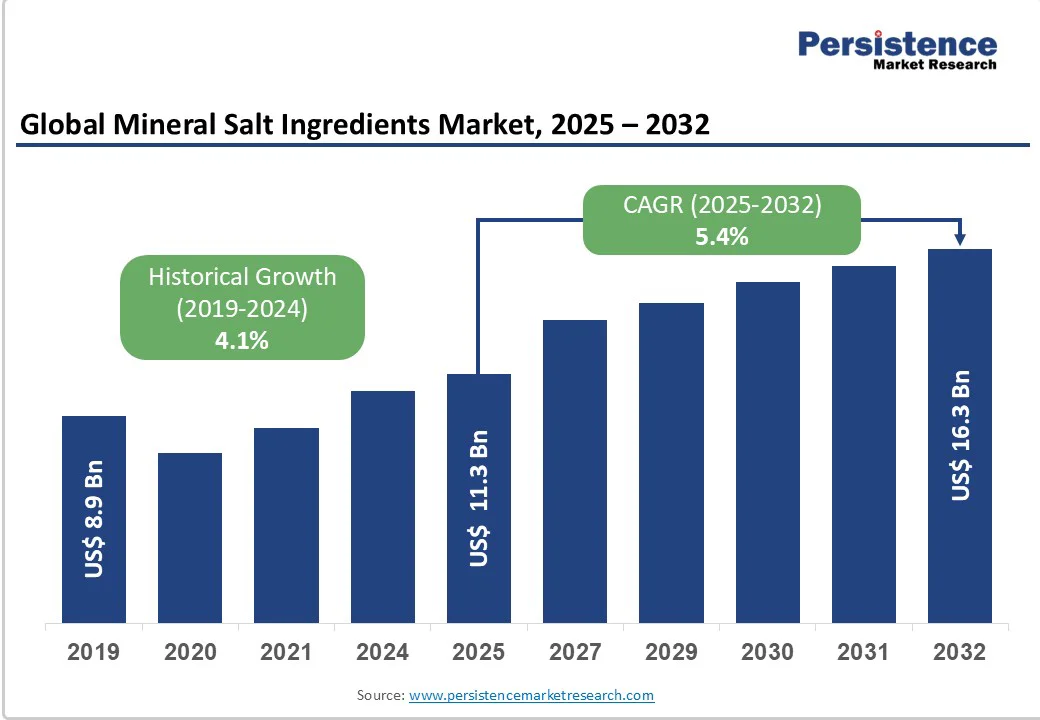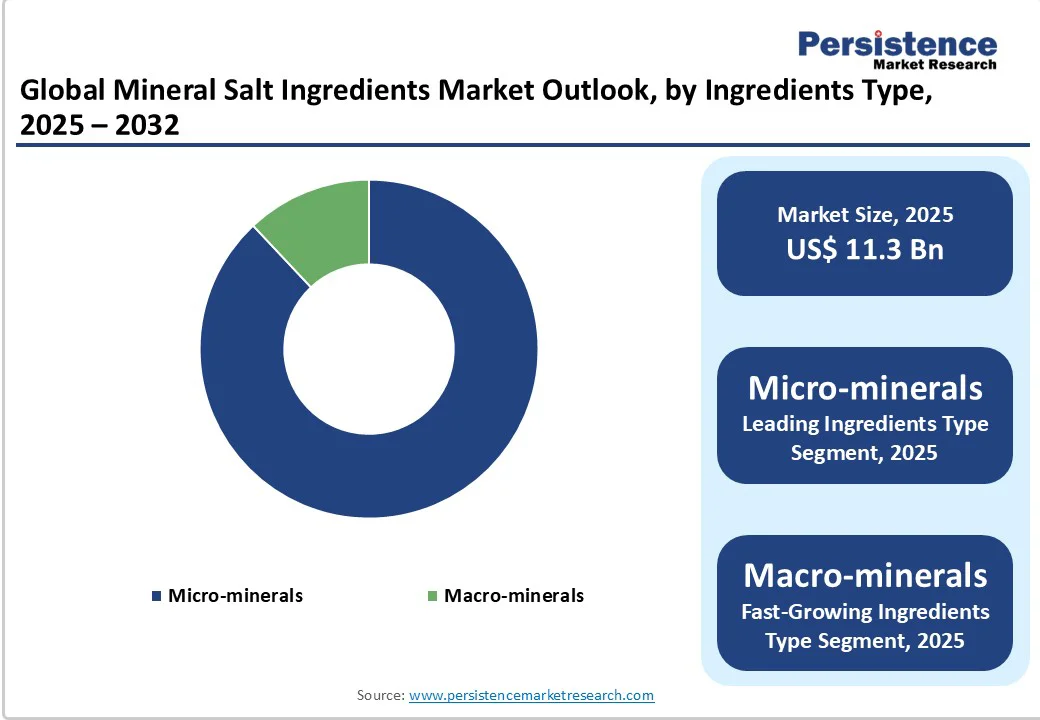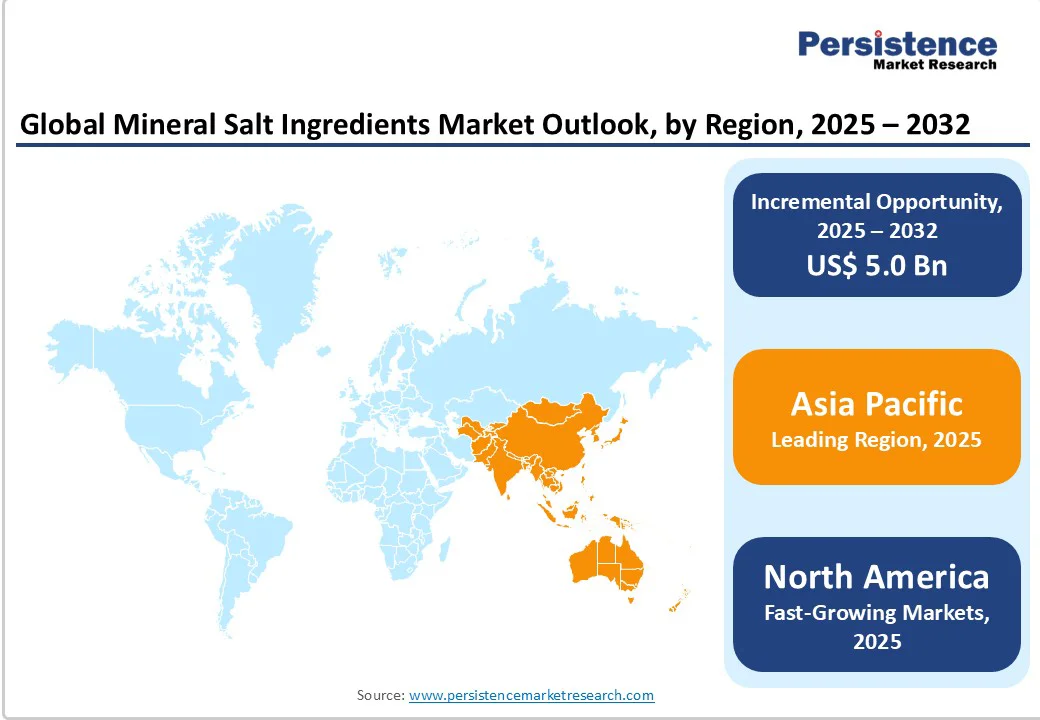ID: PMRREP12040| 198 Pages | 29 Oct 2025 | Format: PDF, Excel, PPT* | Food and Beverages

The global mineral salt ingredients market size is likely to value US$ 11.3 billion in 2025 and is projected to reach US$ 16.3 billion by 2032, growing at a CAGR of 5.4% during the forecast period from 2025 to 2032.
The global mineral salt ingredients market is witnessing steady growth driven by rising health awareness and demand for nutrient-rich products. Key trends include increasing adoption of fortified foods, growing consumption of dietary supplements, and expanding applications of mineral salts in agriculture and animal feed.
| Key Insights | Details |
|---|---|
| Mineral Salt Ingredients Market Size (2025E) | US$ 11.3 Bn |
| Market Value Forecast (2032F) | US$ 16.3 Bn |
| Projected Growth (CAGR 2025 to 2032) | 5.4% |
| Historical Market Growth (CAGR 2019 to 2024) | 4.1% |

One of the key factors driving the global mineral salt ingredients market is the growing emphasis on food fortification and dietary supplements. Food fortification helps improve the nutritional value of everyday food items by adding essential minerals and micronutrients that are not naturally present.
This process helps prevent diseases caused by nutrient deficiencies, such as rickets and pellagra, and supports the healthy functioning of the body. Fortified foods are especially beneficial for children and older adults who often fail to meet their daily nutrient requirements.
The rising awareness about preventive healthcare and the importance of a healthy lifestyle has increased the consumption of dietary supplements worldwide. Consumers are turning toward mineral- and vitamin-based supplements to maintain their health and avoid high medical costs.
The trend is expanding beyond developed regions like North America and Europe to developing economies, where doctors are also recommending supplements. Together, these factors are boosting global demand for mineral salt ingredients.
Environmental concerns have become a major issue for mining and mineral processing companies, as mining activities often lead to biodiversity loss, soil contamination, and other ecological damage.
Growing scrutiny from environmental groups and the media has pushed governments to implement strict regulations aimed at minimizing the environmental impact of mining operations. These policies have created challenges for mineral salt ingredient manufacturers, as facility expansions are now restricted in several countries to comply with environmental standards.
In China, regulatory measures have been introduced to limit industrial emissions through factory consolidation and closures, which are expected to negatively affect the mineral salt ingredients market. China, being one of the largest chemical producers globally, plays a crucial role in market supply, so these restrictions may influence overall growth.
Furthermore, despite ongoing global fortification initiatives, micronutrient deficiencies, especially iron deficiency, remain a major concern due to poverty, lack of awareness, and limited access to fortified foods.
Since this issue cannot be resolved merely by increasing the supply of mineral salts, companies are focusing on awareness campaigns in rural and remote areas. These efforts aim to educate consumers, expand their customer base, and strengthen brand visibility while promoting the importance of mineral nutrition.
The growing use of micronutrients in the agriculture and fertilizer industry presents a significant opportunity for the mineral salt ingredients market. Micronutrients, which include essential vitamins and minerals required by plants in small quantities, play a vital role in improving soil health, plant growth, and crop productivity.
Their increased application helps farmers enhance both the yield and nutritional quality of agricultural produce, thereby supporting the production of food enriched with essential minerals. As awareness about soil fertility and balanced crop nutrition rises, demand for mineral salt-based micronutrient formulations is expected to grow further, offering suppliers strong market potential.
Similarly, the rising utilization of micro- and macro-minerals in animal feed represents another key opportunity. Trace minerals such as iron, zinc, copper, manganese, and iodine are crucial for maintaining animal health, growth, and reproduction.
Livestock producers in developed regions like North America and Western Europe are increasingly fortifying animal feed with these minerals to prevent deficiencies and improve productivity. Although this trend is still emerging in developing regions across Asia Pacific and Latin America, the growing focus on animal nutrition and feed quality in these markets is expected to open new growth avenues for mineral salt ingredient manufacturers globally.
Micro-minerals are expected to dominate the global mineral salt ingredients market, accounting for 88% of the market share in 2025. This dominance is largely driven by the rising demand for essential trace minerals such as iron, zinc, selenium, copper, and manganese, which play a critical role in enzymatic activity, immune function, and overall health maintenance.
Their importance spans various applications, including dietary supplements, infant formulas, therapeutic nutrition, and functional foods, where precise mineral supplementation is crucial. A key factor supporting micro-minerals’ market leadership is the use of chelation technologies, which enhance mineral stability and bioavailability.
For instance, Albion’s TRAACS® technology has demonstrated superior absorption, with clinical studies indicating higher bioavailability compared to conventional inorganic mineral salts. This improved efficacy makes chelated micro-minerals highly preferred by manufacturers and healthcare providers alike. Additionally, growing consumer awareness about preventive healthcare and nutrient deficiencies further strengthens the adoption of micro-minerals across global markets.
The dairy products segment is the leading application area for mineral salt ingredients globally. This growth is driven by the high demand for fortified milk, infant formulas, yogurt, and other dairy-based products enriched with essential minerals such as calcium, magnesium, zinc, and iron. These minerals are critical for bone health, immune support, and overall nutritional well-being, particularly in children, elderly populations, and health-conscious consumers.
Manufacturers are increasingly incorporating chelated minerals and mineral premixes into dairy formulations to improve bioavailability, stability, and taste. Fortified dairy products also benefit from rising consumer awareness about preventive nutrition and the growing preference for functional foods. In addition, regulatory support and industry initiatives promoting fortified dairy products in regions such as North America, Europe, and Asia-Pacific are further propelling market growth.
Overall, dairy products remain the largest and most influential segment in the mineral salt ingredients market, combining strong consumer demand with opportunities for innovation and value-added formulations.

North America's mineral salt ingredients market is advancing through clean-label reformulation and functional food innovation. The U.S. commands the region's leadership with a 73.9% market share. This dominance stems from extensive demand across agriculture, food and beverages, and industrial applications, significantly outpacing Canada's consumption levels.
Consumer demand for reduced sodium options is pushing manufacturers toward potassium-enriched and mineral-balanced salt alternatives across packaged foods and restaurant menus. The region's sports nutrition and wellness sectors are incorporating specialized mineral blends into protein powders, electrolyte drinks, and performance supplements.
Regulatory pressure on sodium reduction, particularly from FDA guidelines, is accelerating reformulation efforts in processed meats, snacks, and canned goods. Manufacturers are leveraging mineral salts to maintain taste profiles while meeting health standards. Growing awareness of magnesium and calcium deficiencies is driving fortification in plant-based foods and beverages. The clean-eating movement is fueling demand for naturally sourced mineral salts, particularly Himalayan pink salt and sea salt varieties.
Asia Pacific is experiencing significant growth in the mineral salt ingredients market, driven by several key factors. China leads global salt production, producing over 64 million tons annually, while India's fortification programs aim to address widespread micronutrient deficiencies.
The region's processed food sector is embracing specialized mineral blends to address widespread micronutrient deficiencies. Manufacturers are incorporating fortified salts into staple products like flour, dairy alternatives, and ready-to-eat meals, responding to increased consumer scrutiny of nutritional labels.
Southeast Asian markets are witnessing accelerated adoption as middle-class expansion fuels demand for premium health-focused products. Indonesia, Thailand, and Vietnam are emerging as key growth markets, with local bakeries and beverage producers reformulating products to include trace minerals like iodine, iron, and zinc.
These developments highlight Asia Pacific's pivotal role in the global mineral salt ingredients market, with substantial opportunities for growth and innovation.

The global mineral salt ingredients market is moderately consolidated, with major players such as Corbion N.V., Dr. Paul Lohmann GmbH KG, and Koninklijke DSM N.V. leading the industry. These companies focus on extensive R&D investments in mineral chelation technologies, bioavailability enhancement, and sustainable sourcing practices to strengthen their market position.
Strategic collaborations and partnerships with dairy, food, and pharmaceutical companies are increasingly adopted to ensure long-term supply security. Moreover, Emerging players are entering niche applications such as plant-based nutrition and sports supplements, while established companies continue expanding their global footprint through product innovation, capacity expansion, and acquisitions, fostering steady market consolidation and growth.
The global mineral salt ingredients market is projected to be valued at US$ 11.3 Bn in 2025.
Increasing emphasis on food fortification, rising demand for dietary supplements, high need of micronutrients in agriculture & fertilizer industry, and increased application of mineral salt ingredients in animal feed are driving market expansion.
The global mineral salt ingredients market is poised to witness a CAGR of 5.4% between 2025 and 2032.
Expanding use in fortified foods, agriculture, and animal feed, along with rising supplement demand and sustainable mineral sourcing initiatives.
Companies such as Corbion, Dr. Paul Lohmann, Jungbunzlauer, K+S AG, and Gadot Biochemical Industries Ltd., and others are some of the major players operating in the global mineral salt ingredients market.
| Report Attribute | Details |
|---|---|
| Historical Data/Actuals | 2019 - 2024 |
| Forecast Period | 2025 - 2032 |
| Market Analysis | Value: US$ Bn and Volume (if Available) |
| Geographical Coverage |
|
| Segmental Coverage |
|
| Competitive Analysis |
|
| Report Highlights |
|
By Ingredients Type
By Application
By Region
Delivery Timelines
For more information on this report and its delivery timelines please get in touch with our sales team.
About Author